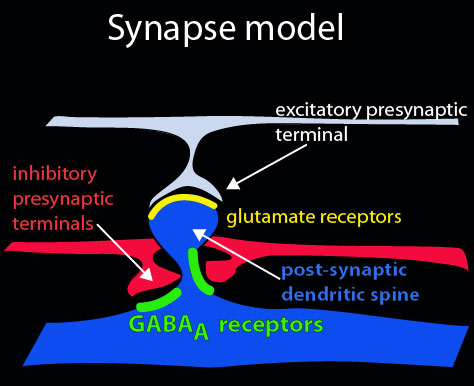| The Jacob lab's broad goal is to understand the impact of dynamically regulated GABAAR surface levels and distribution in normal development and pathological conditions. The lab uses a combination of molecular, biochemical, cell biological and live-imaging approaches. GABAAR are the sites of action of many clinically important drugs, including the benzodiazepines (BZ), which are front line treatments for anxiety, insomnia, schizophrenia and epilepsy. The Jacob lab is investigating modulation of GABAAR trafficking and synaptic inhibition by BZ and other GABAergic agents. Benzodiazepine (BZ) modulation of GABAAR surface levels and synaptic inhibition |
 Another area of research in the lab focuses on the role of GABAergic signaling in CNS development and plasticity. The majority of excitatory synapses in the brain are located at the end of dendritic spines, small protrusions from neuronal processes, with neighboring GABAergic synapses predominantly located on dendritic shafts. We have shown that higher GABAAR surface levels leads to more inhibitory synapses, enhanced inhibitory synaptic transmission and a deficit in mature dendritic spines. Alterations in the excitatory/inhibitory ratio of neuronal signaling, abnormal spine morphology and mutations in GABAAR subunits are associated with many neurological disorders including autism and other neurodevelopmental disorders. The Jacob lab is investigating the contribution of GABAergic inhibition to dendritic spine morphology, movement and plasticity. These studies aim to improve understanding of how GABAergic dysfunction contributes to human neurodevelopmental disorders including autism. Another area of research in the lab focuses on the role of GABAergic signaling in CNS development and plasticity. The majority of excitatory synapses in the brain are located at the end of dendritic spines, small protrusions from neuronal processes, with neighboring GABAergic synapses predominantly located on dendritic shafts. We have shown that higher GABAAR surface levels leads to more inhibitory synapses, enhanced inhibitory synaptic transmission and a deficit in mature dendritic spines. Alterations in the excitatory/inhibitory ratio of neuronal signaling, abnormal spine morphology and mutations in GABAAR subunits are associated with many neurological disorders including autism and other neurodevelopmental disorders. The Jacob lab is investigating the contribution of GABAergic inhibition to dendritic spine morphology, movement and plasticity. These studies aim to improve understanding of how GABAergic dysfunction contributes to human neurodevelopmental disorders including autism.The role of GABAAR membrane trafficking in regulation of dendritic spine maturity |
| |


